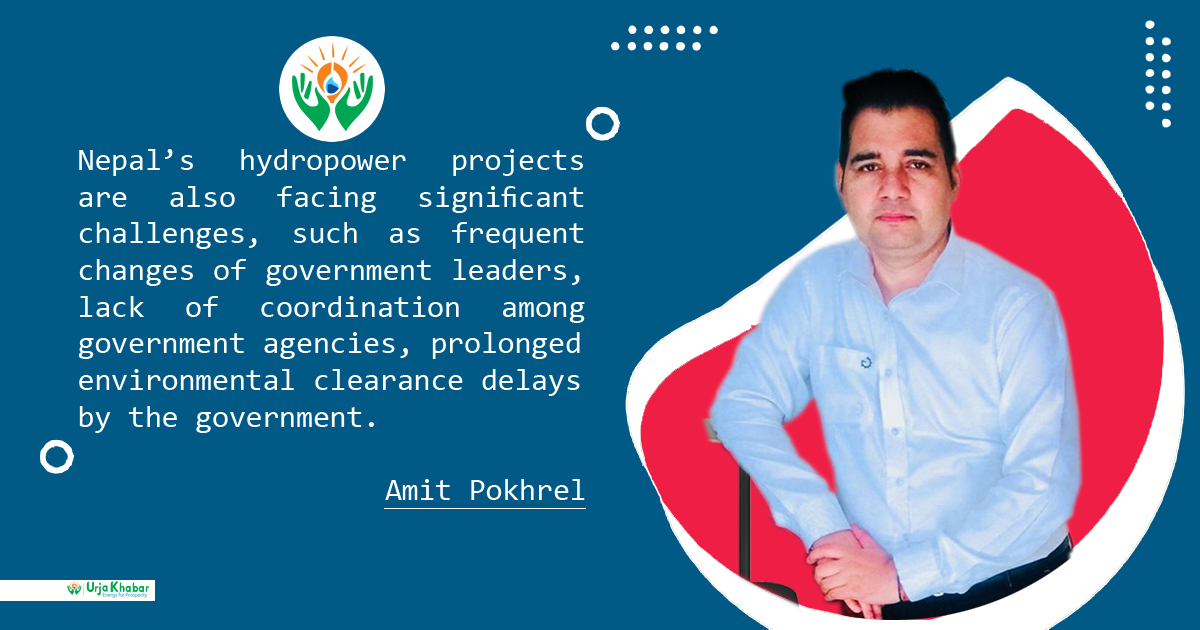
It was not until 1882 AD that the first hydroelectric power plant in the United States of America was constructed in Wisconsin. This plant relied on a fast-moving river as its primary source. Subsequently, artificial water storage areas were constructed at the most suitable locations. These artificial water storage areas also regulated the flow rate of the power station's turbines. The first hydroelectric power station was established in India in 1898 in the state of Darjeeling, and the first hydroelectric plant was established in China in 1912. Initially, hydroelectric power stations were small in size, located at waterfalls close to urban areas, as it was not feasible to transmit electricity over long distances.
Nepal's history of hydropower development traces back to May 22, 1911 (9 Jestha 1968 BS), when the first 500 kW electricity was installed at the Chandra Jyoti Hydropower Plant at Pharping. In 1936, the Prime Minister of Nepal, Dev Shamsher, initiated the inauguration of the 640-kW capacity, Sundarijal Hydropower Plant.

Hydropower is a significant source of energy, providing one fifth of the global electricity supply and its share is rising. Hydropower is currently the most abundant renewable electricity generation technology in the world, and is projected to remain the largest renewable electricity generation technology by 2030. Hydropower is expected to continue to play an important role in the decarbonization of the power system, as well as increasing system flexibility.


The majority of the technically feasible and economically viable hydropower resources have been deployed in developed countries. Developed countries and emerging economies, recognizing the importance of hydropower for the long-term economic growth and prosperity of their economies, have embarked on the various stages of hydropower development.
The National Planning Commission reported that, at the completion of the ninth Five Year Plan, Nepal's population had access to electricity at a rate of 40%. This implies that 60% of Nepal's population still lacks access to electricity, thus demonstrating the existence of a robust electricity market in Nepal. The potential for investment in the hydropower sector in Nepal is boundless due to the vast market for electricity. It is important to bear in mind that the primary form of investment in the hydroelectric sector is an equity investment by entrepreneurs, which is complemented by debt financing provided by financial intermediaries (FIs).
Entrepreneurship cannot be achieved solely through equity investments in hydropower projects. From this point of view, the implementation of hydropower projects also relies on the entrepreneur's capacity to raise debt finance. Nevertheless, there are significant impediments to obtaining funding from financial intermediaries for hydropower investments, which are outlined below.
1. Lack of project financing instruments
2. Lack of Due Diligence Capacities/Capability
3. No proper power development fund like international market
4. Lack in promoting businesses from the private sectors due to interfere from traditional theme and political aspects
5. Unclear policy of Central Bank of Nepal
6. Project Specific and Market Risk
7. Stock Exchange Fluctuation
8. Foreign Exchange Risk like Hedging, fixing dollars and centralizing money into development sectors
9. Regulatory Risks
10. Legislative and Change in Authority Risks
11. Sovereign Risk
12. Revenue Risk
13. Interest Risk and
14. Repayment Risk which can bring liquidity and collapse of businesses
Future of Hydropower development in Nepal
The Nepalese government has established an Investment Board to oversee large-scale infrastructure projects, including hydropower schemes of more than 500 MW, with the primary objective of attracting foreign direct investment into the country. Additionally, the government has also established a hydropower investment and development company to ease financial constraints for the IPPs. However, the company is mandated to cater for projects greater than 25MW.
In comparison, the PPA rate for up to 25 megawatt (MW) is Nepalese rupees NRS.4.80 per unit (USD 0.0365 cents) during the wet season, and NRS.8.40 per unit (USD 0.0639 cents) during the dry season, with a simple yearly price increase of three to five times. For larger than 25 MW, rates are determined through negotiation. Furthermore, there are a number of impediments to the development of hydropower in Nepal, including a lack of political stability and a lack of good governance, as well as law and order issues, which impede progress and economic growth. In addition, Nepal's hydropower project is facing a major setback due to frequent changes in government leaders, a lack of coordination between government agencies, long delays in environmental clearance from the government and a bunch of unnecessary local requirements.
The Himalayan geology of the region is young and prone to earthquakes and landslides, making it difficult to control sediments in hydro projects. The majority of Nepali rivers experience little discharge during the dry season, but become wild during the monsoon. Climate change is a major concern in Nepal, with the Himalayas projected to experience little snow cover over the next 50 years, and the risk of a glacier lake outburst flood posing a major threat to hydroelectricity development. With the establishment of a stable political system, with strong and effective governance, and the removal of various obstacles to the development of hydropower, the future of hydropower in Nepal is highly promising. A well-defined community development policy of providing small portions to local and affected communities may also foster goodwill and support for hydropower developments.
Hydropower Challenges
Investing in the stock market can be a risky endeavor unless one is well-informed and has a thorough understanding of the market. With the recent share opening of hydropower project developers from both public and private sectors, the share prices have seen a surge in both enthusiasm and uncertainty. Investors invest in the company's shares in the expectation that they will generate profits through dividends or capital gains over time. The stock market is likely to increase in value over time, thus increasing the wealth of the shareholder. However, due to the frequent fluctuations of the stock prices, many investors have exited the market, some of whom have made substantial profits.
According to the disclosure report, the hydropower listed companies listed on the Nepal Stock Exchange (NEPSE) have not paid any dividend to their shareholders, and the market price of these companies is lower than the nominal amount or the amount invested when buying the shares in the initial public offerings (IPOs). In 2015 and 2016, most of these companies were oversubscribed by more than a dozen times.
Even the media reported the stories on these IPOs without deeper analysis of the companies and their projects. All these statements are misleading and have proven costly to many people.
For example, the rush for started with the success of Chilime Hydropower Company Limited, which was given a favorable electricity price by the Nepal Electricity Authority (NEA). According to a study titled “Local Shares: An in-depth examination of opportunities and risks for local communities seeking to invest in Nepal’s hydropower projects”, commissioned by International Finance Corporation (IFC) and Australian Aid in 2018, local communities who invested in hydropower shares expected lucrative gains like many shareholders of Chilime, but the lack of financial literacy among the investors coupled with the lack of governance in the sector posed high risks. Chilime, whose electricity was given higher price rates by the NEA because the NEA staffers themselves were investors in the company, has already distributed 292 percent dividends — 117 percent cash and 175 percent bonus dividends.
It is alleged that the government breached the fiduciary duties of investors by allowing the company under its flagship program to launch an IPO without obtaining a third-party rating, which is customary for private companies. However, experts and investors suggest that the hydroelectricity companies conceal their costs up until the time of the IPO, which are in fact significantly higher than indicated in their documents.
Furthermore, the promoters are not actually investing the amount committed; rather, they are artificially inflating the project and adjusting their investments accordingly. Only a few hydroelectricity companies are yet to pay dividends, and many have no revenue to distribute, even though the projects are functioning normally, as promoters have obtained their projects from the banks with inflated costs. These inflated costs have reduced the profits that investors would have received.
Nepal’s hydropower projects are also facing significant challenges, such as frequent changes of government leaders, lack of coordination among government agencies, prolonged environmental clearance delays by the government, high levels of corruption and demand for donations and handouts, and a lot of redundant local requirements. However, with the emergence of stable political systems, strong and efficient governance, and removal of various barriers to hydropower development, Nepal’s future in hydropower is very promising. A clearly defined community development policy to provide small portions of shareholdings to local and impacted communities may also help to build trust and promote hydropower development.
The author is is a project expert who has been contributing to the of Golyan Group
References
• Nepal Planning Commission Document based for Energy, Water Resources
• Article: Hydropower promise in Nepal - International Water Power
• Hydropower Development in Nepal - Climate Change, Impacts and Implications IntechOpen
• How hydro companies are cheating shareholders - myRepublica - The New York Times Partner, Latest news of Nepal in English, Latest News Articles
• Track the performance of Hydropower companies by the end of the second quarter on the basis of major financial indicators - || ShareSansar ||
• INVESTMENT IN HYDROPOWER Boon for The Vulnerable | New Spotlight Magazine
• How many companies are on the verge of collapsing in terms of share price? Which sector leads in this aspect? - || ShareSansar ||
• https://archive.nrb.org.np/ecorev/pdffiles/vol18_art4.pdf
• https://www.slideshare.net/SarojUpadhyay/hydropower-development-in-nepal-68419644
• https://www.adb.org/sites/default/files/publication/612641/hydropower-development-economic-growth-nepal.pdf
• https://www.hydropower.org/country-profiles/nepal
• http://www.lawcommission.gov.np/en/wp-content/uploads/2018/09/hydropower-development-policy-2058-2001.pdf
• https://www.adb.org/publications/hydropower-development-economic-growth-nepal
• https://d2ouvy59p0dg6k.cloudfront.net/downloads/hsap_study_nepal.pdf
• http://www.edcnepal.org/wp-content/uploads/2018/11/DAY-4-LECTURE-1-Current-state-Challenges-opportunities-in-hydro.pdf
• https://www.hydropower.org/country-profiles/region-east-asia-and-pacific
• https://www.sciencedirect.com/science/article/abs/pii/S0301421519301193
• https://kathmandupost.com/columns/2019/09/12/development-of-hydropower-in-south-asia-requires-a-perspective-makeover
• https://www.nsenergybusiness.com/news/hydropower-investment-in-asia/
• https://www.hydropower-dams.com/asia-2020/wp-content/uploads/Asia_2020.pdf
• https://www.ifc.org/wps/wcm/connect/news_ext_content/ifc_external_corporate_site/news+and+events/news/nepal+hydropower
